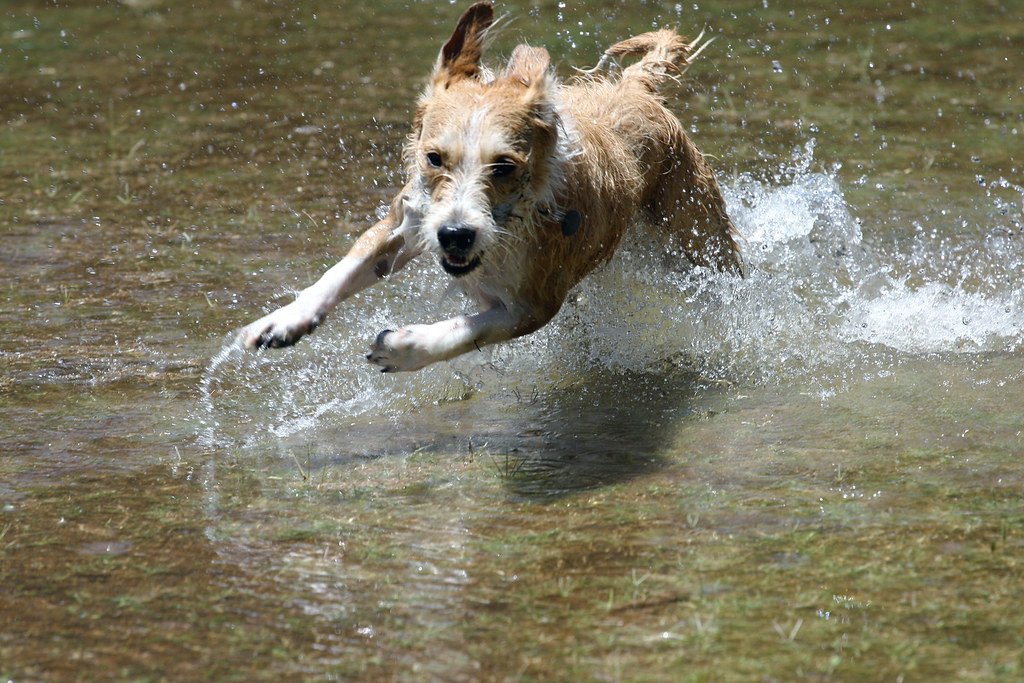On a sunny afternoon, as the wind whispers through the trees, you witness a sudden blur of fur racing across the yard, knocking over everything in its path. The hyperactivity of some dogs can often be overwhelming, leading to a constant struggle for pet owners. But fear not! In this captivating article, we delve into the world of dog training for hyperactivity, aiming to calm the storm that rages within these energetic canines. With a neutral perspective, we offer insightful strategies and techniques to help transform your four-legged tornado into a serene and well-behaved companion. So, fasten your seatbelts and prepare to embark on a journey where patience and understanding become essential tools in taming the whirlwind of hyperactivity.
Table of Contents
- Understanding the Root Causes of Hyperactivity in Dogs
- Developing an Effective Training Routine for Hyperactive Dogs
- Incorporating Mental Stimulation Techniques to Calm Hyperactive Dogs
- Implementing Positive Reinforcement Methods for Long-Term Behavioral Changes
- Creating a Safe and Peaceful Environment for Hyperactive Dogs
- Q&A
- To Wrap It Up

Understanding the Root Causes of Hyperactivity in Dogs
Hyperactivity in dogs can present a wide range of challenges for both pet owners and their furry friends. It is crucial to understand the root causes behind this behavior in order to effectively manage and address it. Here are some factors that may contribute to hyperactivity in dogs:
- Genetics: Certain dog breeds are naturally more energetic and prone to hyperactivity, such as Border Collies and Jack Russell Terriers. These breeds require plenty of mental and physical stimulation to prevent restless behavior.
- Lack of exercise: Dogs need regular exercise to burn off excess energy. A lack of physical activity can lead to restlessness and hyperactivity. Ensuring they receive daily walks, playtime, and would even benefit from activities such as agility training or dog sports.
- Boredom: Dogs are intelligent creatures that thrive on mental stimulation. When they are left alone for long periods without any toys or activities to engage with, they may become hyperactive. Providing interactive toys, puzzle feeders, and rotating their toys regularly can help alleviate boredom.
- Stress and anxiety: Like humans, dogs can experience stress and anxiety, which may manifest as hyperactive behavior. Common triggers include separation anxiety, loud noises, or changes in their environment. Creating a safe and comfortable space for your dog, using calming aids such as pheromone diffusers or consulting a veterinarian for behavior modification techniques can help reduce stress.
Understanding the root causes behind hyperactivity in dogs allows pet owners to take proactive measures to manage their dog’s behavior effectively. By addressing these factors, providing proper exercise, mental stimulation, and managing stress, it is possible to create a calmer and happier environment for both the dog and their human companions.

Developing an Effective Training Routine for Hyperactive Dogs
Is your hyperactive pup causing chaos in your home? Don’t despair! With a well-designed training routine, you can redirect their boundless energy into positive behaviors. Here are some key strategies to help you develop an effective training routine for your hyperactive dog:
1. Establish a Consistent Schedule: Hyperactive dogs thrive on routine. Set a daily schedule for feeding, exercise, training sessions, and rest. Consistency will provide a sense of structure for your furry friend, helping them to stay focused and calm.
2. Channel Energy Through Physical Exercise: Hyperactive dogs need plenty of physical exercise to release their pent-up energy. Design a routine that includes brisk walks, runs, or play sessions at least twice a day. Engage in activities that require them to chase and fetch, providing mental stimulation as well.
3. Incorporate Mental Stimulation: An active mind can exhaust a hyperactive dog as much as physical exercise. Add interactive games and puzzle toys to their routine. Engaging their problem-solving skills will help burn off mental energy, leaving them more relaxed.
4. Teach Basic Commands: By teaching your hyperactive dog basic commands such as sit, stay, and lay down, you can redirect their energy into positive behaviors. Use positive reinforcement techniques like treats and praise to reward desired actions.
5. Implement Relaxation Techniques: It’s essential to teach your hyperactive dog how to calm down and relax. Practice relaxation techniques such as massage, gentle grooming, or using calming sprays or diffusers in their environment. Encourage them to settle down and create a peaceful atmosphere.
By incorporating these strategies into your training routine, you can help your hyperactive dog become more disciplined and well-behaved. Remember, patience and consistency are key when working with energetic pups. With time and effort, you’ll witness remarkable progress and a harmonious bond with your furry companion.
Incorporating Mental Stimulation Techniques to Calm Hyperactive Dogs
One effective way to calm hyperactive dogs is by incorporating mental stimulation techniques into their daily routine. Mental stimulation not only helps to channel their excessive energy but also provides a healthy outlet for their natural instincts. Here are some innovative techniques that can assist in calming your hyperactive furry friend:
– Puzzle toys: Engage your dog’s mind with interactive puzzle toys. These toys require your dog to use problem-solving skills to access treats or toys hidden inside. Not only will this keep them entertained for hours, but it will also tire them out mentally, promoting a sense of relaxation.
- Nose work: Dogs have an incredible sense of smell, and engaging their olfactory senses can do wonders to calm them down. Create interactive games using treats or scented objects and have your dog search for them. This activity not only stimulates their brain but also taps into their natural hunting instincts.
– Training sessions: Regular training sessions provide mental stimulation and help establish a strong bond between you and your furry companion. Incorporate obedience exercises, tricks, and agility training into their routine. This will not only tire them out mentally but also keep their focus on you, reducing their hyperactivity.
By incorporating these mental stimulation techniques into your hyperactive dog’s routine, you can help them release excess energy and promote a calmer state of mind. Remember to provide these activities consistently, as mental stimulation is an ongoing process that requires regular engagement.
Implementing Positive Reinforcement Methods for Long-Term Behavioral Changes
Positive reinforcement is a powerful tool when it comes to making long-term behavioral changes. By focusing on rewarding desirable actions and behaviors, individuals can be motivated to consistently make positive choices. Implementing positive reinforcement methods involves creating a structured system of rewards that encourage and support lasting change.
One effective approach is using a combination of tangible rewards and verbal praise. Tangible rewards can be in the form of small incentives such as stickers, tokens, or even certificates of achievement. These physical rewards can serve as a visual reminder of progress and can create a sense of pride and accomplishment. Verbal praise, on the other hand, is a simple yet significant way to acknowledge and reinforce positive behavior. A sincere compliment or recognition can go a long way in boosting self-confidence and encouraging individuals to continue their efforts.
Another essential aspect of implementing positive reinforcement methods is setting achievable goals and tracking progress. Breaking down larger goals into smaller, manageable steps can help individuals feel a sense of accomplishment along the way. Creating a visual tracker, such as a chart or checklist, can provide a visual representation of progress and serve as a motivating reminder of how far one has come. Progress trackers can be particularly effective when combined with intermittent rewards, where individuals are rewarded at specific milestones, ensuring that positive behavior becomes consistently reinforced over time.
Creating a Safe and Peaceful Environment for Hyperactive Dogs
As pet owners, we understand the challenges of having a hyperactive dog and the importance of providing them with a safe and peaceful environment. Here are some tips to help create a harmonious atmosphere for your energetic furry friend:
- Designated Play Areas: Set up specific play areas in your home where your hyperactive pup can burn off their excess energy. These areas should be free from any hazards or fragile items that could be damaged during their play sessions.
- Engaging Toys: Provide a variety of interactive toys that can keep your hyperactive dog mentally stimulated. Puzzle toys and treat-dispensing gadgets are excellent options, as they can help redirect their excess energy in a positive way, keeping them occupied and entertained.
- Calming Spaces: Create quiet, cozy spots in your home where your hyperactive dog can retreat to when they need a break. Adding a comfortable dog bed or a calming blanket can help them relax and unwind, promoting a sense of security and peace.
- Regular Exercise: Make sure your hyperactive dog gets plenty of physical exercise. Long walks, runs, or play sessions in the park are essential to drain their energy levels. Consider incorporating activities like obedience training or agility courses to engage their minds as well.
Remember, a safe and peaceful environment is crucial for hyperactive dogs to thrive. By implementing these strategies, you’ll create a space where your furry companion can be comfortable, happy, and enjoy a balanced lifestyle.
Q&A
What are common signs of hyperactivity in dogs?
Common signs of hyperactivity in dogs include constant barking, excessive energy, difficulty focusing, and trouble settling down.
How can I help manage my hyperactive dog’s energy?
To manage your hyperactive dog’s energy, try providing plenty of physical exercise, mental stimulation through interactive toys or training, and establishing a consistent daily routine.
Are there specific dog breeds more prone to hyperactivity?
While any dog can be hyperactive, certain breeds like Border Collies, Jack Russell Terriers, and Weimaraners tend to have higher energy levels and may be predisposed to hyperactivity.
What is positive reinforcement training and how can it help with hyperactivity?
Positive reinforcement training involves rewarding good behavior, which can help redirect and calm hyperactive dogs. This type of training focuses on encouraging desired behaviors rather than punishing unwanted ones.
Should I consider medication for my hyperactive dog?
Medication should be a last resort and should only be prescribed by a veterinarian. It is important to explore other training and management techniques before considering medication.
Can a structured routine help in calming a hyperactive dog?
Yes, establishing a structured routine can greatly benefit a hyperactive dog. They thrive on predictability and having consistent meal times, exercise periods, and training sessions can help them feel more balanced and calm.
What role does mental stimulation play in calming hyperactive dogs?
Mental stimulation is crucial for hyperactive dogs as it helps redirect their excess energy and focuses their minds. Engaging them in activities like puzzle toys, scent work, or obedience training can tire them mentally, promoting calmness.
How can I teach my dog to relax and settle down?
Teaching your hyperactive dog to relax and settle down can be achieved through training exercises such as capturing calm moments and reinforcing them with rewards, gradual desensitization to stimuli, and providing a quiet, comfortable space for relaxation.
Is professional help necessary for training a hyperactive dog?
In some cases, professional help may be beneficial, especially if the dog’s hyperactivity is causing significant disruption or if previous training attempts have been unsuccessful. A qualified dog trainer or behaviorist can provide guidance and customized strategies for managing hyperactivity.
To Wrap It Up
As we conclude this journey through the world of dog training for hyperactivity, we hope that our shared insights have provided a glimmer of hope and ignited newfound motivation within you. Like a swirling storm, hyperactive behavior in dogs can easily overwhelm even the most patient of owners. But fear not, for with dedication, patience, and a sprinkle of creative finesse, it is possible to calm the tempest that lies within.
May you walk away from this article armed with a toolkit filled with effective techniques and understanding, ready to embark on a transformative adventure with your beloved furry companion. Remember, each dog is unique, and what works for one may not work for another. Embrace the whimsical journey of discovery as you tailor your training methods to suit your dog’s individual quirks and personality.
In the midst of this turbulent storm, it is essential to remain grounded and steadfast. Allow the beacon of positivity to guide your path as you navigate uncharted territories filled with excitement and occasional setbacks. Even amidst the whirlwind of hyperactivity, take a moment to appreciate the untamed energy that makes your dog truly unique.
With time, practice, and a sprinkle of magic, you will witness remarkable transformations unfold before your very eyes. The once frenzied whirlwind of hyperactivity will slowly give way to a more balanced, harmonious state of being. Celebrate the milestones, however small they may seem, for they are the stepping stones to lasting change.
And so, as we bid adieu to this chapter of dog training for hyperactivity, we encourage you to embark on this grand adventure with an open heart and open mind. Embrace the storm, for within it lies the potential for growth, learning, and unparalleled companionship. With compassion and gentle guidance, you have the power to transform your four-legged friend from a wild wind to a gentle breeze. Let the calming whispers of understanding and patience guide you towards a lifetime of joy and serenity with your beloved furry companion.
As an affiliate, my content may feature links to products I personally use and recommend. By taking action, like subscribing or making a purchase, you’ll be supporting my work and fueling my taco cravings at the same time. Win-win, right?
Want to read more? Check out our Affiliate Disclosure page.